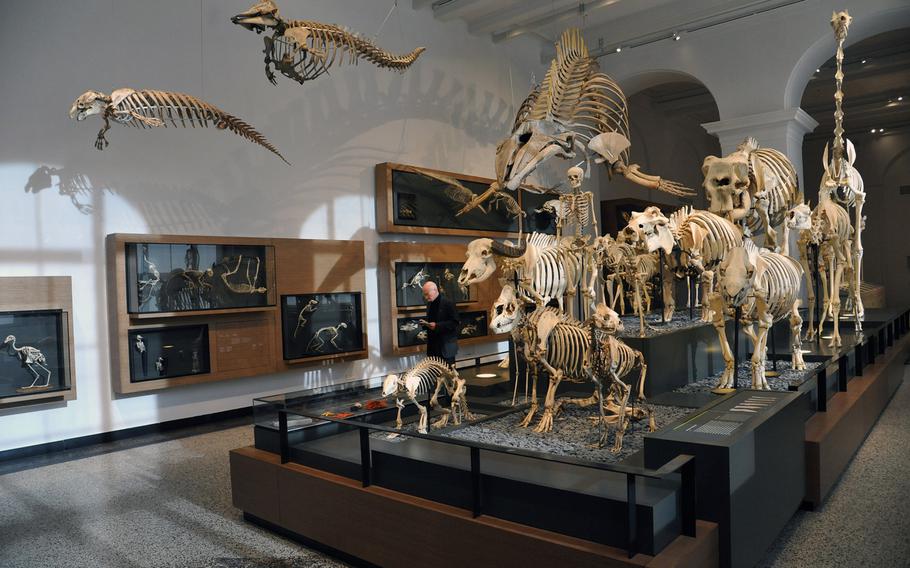
Skeletons of various birds, fish and mammals are on display in the zoology section of the Hesse State Museum in Darmstadt, Germany. (Michael Abrams/Stars and Stripes)
When the Hesse State Museum reopened in September, it was like finding a long-lost friend, a place where many rainy days had been spent over the years.
The Hessisches Landesmusem Darmstadt, as it is known in German, closed in 2007 for renovations that were supposed to last five years. But structural damage found during the renovation and lack of funds to build a new wing, requiring restoration of an existing one from the 1980s, delayed the reopening.
So when the doors finally did reopen, nearly 77,000 visitors streamed to the museum in the first 100 days to see what has changed. Surprisingly, not much has.
The giant mastodon skeleton still stands in the entrance to the second-floor geological and life history exhibit; the ground floor still has its large collection of zoology specimens and wildlife dioramas; and the museum’s wonderful Art Nouveau collection is still in the basement.
The first specimens exhibited here were collected by the grand dukes of Hesse in the 17th century.
The museum got its start in 1820 when Grand Duke Ludewig I of Hesse endowed his private collection to the state. The building itself was designed by Alfred Messel and opened in 1906. Like much of Darmstadt, it was destroyed in World War II. It was rebuilt, but by 2007 was in serious disrepair.
The collection has grown over the years, and today the museum is a conglomeration of natural history and art.
While the phrase, “something for everyone,” might be overused, here it fits well. In addition to the exhibits mentioned above, the museum features among other things: medieval weapons and armor; applied arts through the 19th century; pre-and early history, including Bronze Age and Egyptian artifacts; 18th-century to-scale cork models of Roman buildings; and a collection of fossils from the nearby Messel Pit Fossil Site. The site is on the World Heritage List and is one of the richest sites for fossils from the Eocene period.
The biggest change to the museum is how and where much of the art is displayed.
Before the closing, the wing that was to be replaced housed the museum’s modern art collection. But now its two floors are home to paintings from the 13th through 20th centuries. The old paintings could have looked out of place in an angular building designed for modern art, but the way the old and new pieces are sometimes intermingled works.
On the main building’s third floor is art from after 1945 with works by Gerhard Richter and Sigmar Polke and the Beuys Block, a collection of works by Joseph Beuys, a controversial German artist who used such things as felt, lard and garbage in his works.
The Forest of Sculptures, a gift from the late collector Simon Spierer, includes works from such artists as Henry Moore, Alberto Giacometti and Max Ernst. Aptly named, the exhibit encompasses 40 sculptures spread across three rooms.
If you are into art, love science and are fascinated by antiquity, plan to spend a day at the museum.
Hesse State Museum (Hessisches Landesmuseum)Directions: The Hessisches Landesmuseum is in downtown Darmstadt, north of the Schloss (palace), just outside of the pedestrian zone at Friedensplatz 1. Parking is available at the Schlossgaragen under the museum. On public transportation, get off at the Schloss stop.
Times: Tuesday, Thursday and Friday 10 a.m. to 6 p.m.; Wednesday 10 a.m. to 8 p.m.; Saturday, Sunday and German holidays 11 a.m. to 5 p.m. Closed Mondays, Good Friday and Dec. 24 and 31.
Costs: Admission is euros for adults; children up to age 18 enter free.
Food: Cafe Rodensteiner is on the ground floor of the museum and features light German fare. If you like Turkish/Arabic food, try Haroun’s, a popular place at Friedensplatz 6 (closed Sundays).
Information: The museum’s German language Web site is www.hlmd.de.